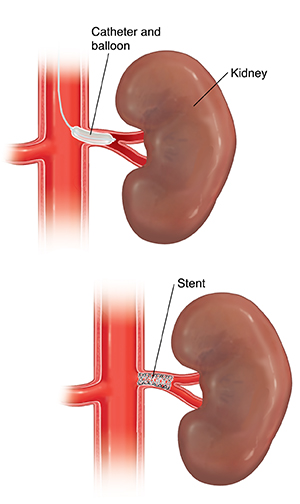Renal Angioplasty and Stenting
Renal angioplasty is a procedure that uses a small balloon to widen the passage through your renal artery. This is the main blood vessel that supplies your kidneys. A stent is a small metal mesh tube put into a blood vessel to help hold it open and improve the blood flow.
If your renal artery is narrowed or blocked, it can cause severely high blood pressure or problems with how your kidneys work. Renal angioplasty and stenting can help make blood flow to your kidney better and ease problems. The procedure is often done by a specially trained healthcare provider called an interventional radiologist. This is a healthcare provider who is trained and certified by the American Board of Radiology to use minimally invasive image-guided procedures to diagnose and treat diseases.

Before your procedure
Follow any directions you are given on how to get ready. This includes any directions you’re given for not eating or drinking before the procedure.
Tell your healthcare provider if you:
-
Are allergic to X-ray dye (contrast medium) or other medicines
-
Are breastfeeding
-
Are pregnant or think you may be pregnant
-
Have any health conditions
-
Have had any recent illnesses
Tell your healthcare provider about all medicines you take. You may need to stop taking some or all of them before the test. This includes:
-
All prescription medicines
-
Herbs, vitamins, and other supplements
-
Over-the-counter medicines, such as aspirin or ibuprofen
-
Illegal drugs
During your procedure
-
You'll change into a hospital gown and lie on an X-ray table. An IV (intravenous) line is started in your arm or hand. This is to give you fluids and medicines. You may be given medicine through the IV to help you relax.
-
Medicine will be put on the skin at the insertion site to numb it. The insertion site is often in the groin. Then a needle with a thin guide wire is put through the skin into the blood vessel. A thin, flexible tube called a catheter is placed over the guide wire into the blood vessel.
-
X-ray dye is injected into the blood vessel. The radiologist uses X-ray images (fluoroscopy) as a guide. They move the catheter through the blood vessels to your kidney.
-
When the special catheter (angioplasty catheter) crosses the narrowed or blocked area, the radiologist inflates a special balloon attached to the catheter. This widens the artery (angioplasty). This part of the procedure may be done more than once with balloons of different sizes.
-
A stent may be put in to hold the blood vessel open. To do this, a catheter with a stent on it is threaded over the guide wire. The stent is opened when it reaches the narrowed area. The stent stays in the artery. The catheters and balloons are taken out.
-
When the procedure is done, pressure is put on the insertion site for 15 minutes to stop bleeding.
After your procedure
-
You may be told to lie flat and keep the leg with the insertion site straight for 6 hours to stop bleeding.
-
You may stay in the hospital overnight. If you don't stay in the hospital, you should have a friend or relative drive you home.
-
Drink plenty of fluids to help flush the X-ray dye out of your body.
-
After you go home, care for the insertion site as directed.
-
If you have a stent, you may need to take aspirin or a blood-thinning medicine (anticoagulant) after the procedure. This will help prevent blood clots. Talk with your healthcare provider about this.
Possible risks
-
Bruising at the insertion site
-
Bleeding inside your body or around the insertion site
-
Damage to the artery. This includes the blockage getting worse and possible kidney damage. This may result in kidney failure and needs long-term dialysis.
-
Infection
-
Problems because of the X-ray dye, including allergic reaction or kidney damage
Online Medical Reviewer:
Neil Grossman MD
Online Medical Reviewer:
Rita Sather RN
Online Medical Reviewer:
Tara Novick BSN MSN
Date Last Reviewed:
12/1/2022
© 2000-2024 The StayWell Company, LLC. All rights reserved. This information is not intended as a substitute for professional medical care. Always follow your healthcare professional's instructions.